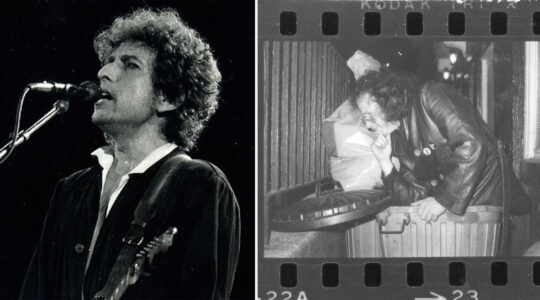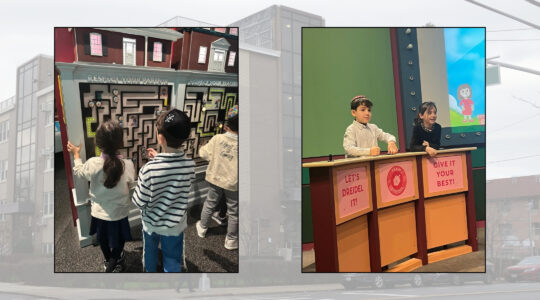Emanuel Ringelblum knew Jewish Eastern Europe the way the Stage Manager in “Our Town” knew Grover’s Corners. The Tevye era was modern for Ringelblum, whose doctorate was on the Jews of Warsaw — only up to 1527.
Surely he could tell you the legend of Esterke, the beautiful Jewish mistress of King Casimir, in the 1300s, who seduced his majesty into granting favors for Esterke’s people who moved along the rivers, across the farmlands, into the forests of central Europe.
Living in the 1930s, the Indian Summer of Polish history, Ringelblum, a writer and historian for both YIVO and the Joint Distribution Committee, was as besotted as the old king with Esterke’s mythical Yiddish children. There was nothing about Yiddishkeit that didn’t fascinate and intrigue him. And when Ringelblum ended up on the sorry side of the Warsaw Ghetto walls, he created the secret “Oyneg Shabes” group, dedicated to documenting the end of the story, as he once tried to document the beginning.
Oyneg Shabes not only reported on the ghetto’s daily fate, but was intent on preserving every proof of life: the theater flyers, Yiddish candy wrappers, rabbinic ghetto responsa, the games of children, poetry, memory, until the night when they buried it all in metal boxes, and later in milk cans, in the hope that — what? Would there be any Jews left alive to care or to find it? In fact, some of it was never found at all.
Now, this month, very much in the spirit of Oyneg Shabes, and its posthumous victory, YIVO has launched its online YIVO Encyclopedia of Jews in Eastern Europe (www.yivoencyclopedia.org), an expanded — and completely free — version of the $400 print edition published by Yale University Press in 2008.
The print edition had more than 1,800 entries. The easy to navigate online edition not only has expanded the list of articles (though not enough) but, along with Ringelblum (under “R”) and how it all ended (under “H”) the encyclopedia has added 1,400 media items — rarely if ever, seen before.
Here is the proof of beautiful lives, the closest we’ll come to primary sources of memory: 40 audio recordings — Yiddish musical theater, davening, klezmer bands, even excerpts from wedding services and badkhan (jester) routines; 70 video clips — of outdoor markets, urban and shtetl scenes, brass bands, schools and summer camps; and 192 documents — letters and notes from the greatest Yiddish writers, historical figures such as Leon Trotsky, ration cards from the ghetto, and dozens of photographs and holiday cards, almost as if written from your great-grandparents to the children they never met.
Unfortunately, most of the documents are in Yiddish or Russian, with only the barest English summary.
There is a photo of a synagogue’s courtyard — a shulhoyf — that looks so inviting, it’ll make you wish you went to that shul just so you could walk out of it.
Even the encyclopedia articles have a terrific Yiddish quality. For example, the entry “Talk” is not about what a speech therapist might know but about what is, arguably, the Jewish national pastime, the stories, the blessings, the curses and the clever, the shmoozing, the sheer joy in an endless summer Shabbos of it.
Likewise, the entry on “Memory” has nothing to with a sector of the brain but with the mystery of us. We’re introduced to a passage from 1894 — in the birth pangs of not only Zionism, but Yiddish and Hebrew literature, and the upheavals of migrations — by the great Sholem Yankev Abramovitsh (a.k.a. Mendele Mochir Sforim), looking, with a wink, at the state of Jewish heroism on the cusp of what turned out to be the most heroic Jewish century of all: “Dukes, governors, generals, and soldiers we were not… we didn’t fight duels… we didn’t dance the quadrille at balls; we didn’t hunt wild animals in the fields and forests; we didn’t make voyages of discovery to the ends of the earth; we carried on with no actresses or prima donnas…. In short, we were completely lacking in all those colorful details that grace a story and whet the reader’s appetite.” And yet.
There are entries on toys, sexuality, lullabies, love, and we learn why so many Jews ended up running taverns. We learn about set design in Yiddish theaters, and that “Jewish pimps and prostitutes were a conspicuous presence in the front rows.”
We learn about breastfeeding, that “sometimes the holy names (of God) were written in ink on the breast, so that the ink would ‘mix’ with the mother’s milk and the suckling child would develop a thirst for the Torah.”
We learn that there were 99 Orthodox shuls in Minsk, but only three were chasidic.
We learn that outrageously expensive weddings did not begin in America. “So elaborate did some wedding celebrations become that Jewish communal authorities imposed sumptuary regulations to rein in lavish excesses (or at least their display).”
Browsing, the heart keeps returning to the amateur “home movies,” some less than a minute long but as enchanting as a firefly for those fleeting seconds.
Watch – snippets of a film taken in the 1930s by Gustav Eisner, an American Jewish travel agent – of an outdoor fish market in Lodz. On what looks like a cold day, with all the men in overcoats and caps, a man reaches into a barrel and pulls out a flopping fish.
Who was Earl Morse? In 1935, a tourist in Poland, he shot several minutes of video in Krakow: A horse-drawn carriage clip-clops through mostly empty streets. A young woman wears a short-sleeved belted dress on a sunlit day, as she looks down the block, perhaps waiting for a friend.
It makes you wonder, are the Jews we see today in Riverside Park, or in the shadows of the Brooklyn train trestles, any less beautiful, any less poignant?
Morse goes to a more crowded part of town, the buildings have the ornate architecture of an earlier time. The men are modern, elegant, in pinched collars and ties, carrying rolled-up papers. A man holds a child by the hand. A man, passing a kiosk, turns and takes a quick glance at 20 uniformed men marching in the street. A trolley comes from the other direction. A moment in time, 1935.
Of course, like a Hollywood film that opens with a gun being loaded, you watch knowing what is coming, wanting to warn – or kiss goodbye – every person on-screen. The casual tourist turns his camera to Krakow’s medieval Wawal Castle. Four years later, this tourist attraction becomes the local Nazi headquarters.
A Stalin-era clip from 1929 shows the building of wooden homes along a river in Birobidzan, filmed by an academic expedition from Brigham Young University, of all places.
Unfortunately, the encyclopedia is diminished by errors. We’re told that Moses died on the Tenth of Tevet when every child in cheder would have known, without looking it up, that Moses died on Adar 7.
If you’re planning to look up your grandparents’ hometown, you may be disappointed. An encyclopedia is expected to be encyclopedic but this one is not. Numerous towns in Eastern Europe with entries in the Encyclopedia Judaica have no entry here.
Joseph Opatoshu, a widely anthologized Yiddish writer, is all over the YIVO encyclopedia, with 34 different references, ranging from his relationship to Marc Chagall, to being asked to identify Oyneg Shabes documents, to being called “a leading literary figure” in yet another entry. But who was he? Where was he from? Why was he so sought out, so important to so many? We’re not told. There is no “Joseph Opatoshu” entry, only scattered fragments.
Another problem is multiple spellings. We’re told the poet Itzik Manger came from Czernowitz (but not what country) but his Jewish newspaper was the “Tshernovitser” but the town’s entry is spelled Chernivtsi, with no hyperlinks to help, making research far more difficult than necessary.
Let’s hope this edition is only a beginning. If it is, it’s a good one.
|
Signup for our weekly email newsletter here. Check out the Jewish Week’s Facebook page and become a fan! And follow the Jewish Week on Twitter: start here. |
The New York Jewish Week brings you the stories behind the headlines, keeping you connected to Jewish life in New York. Help sustain the reporting you trust by donating today.




